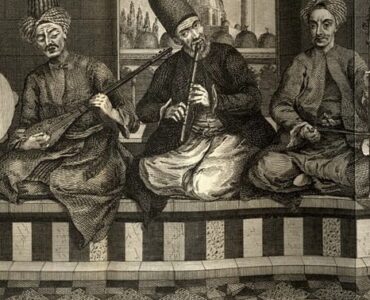
Samaritanism
Samaritanism is a closely affiliated religion with Judaism, practiced by the ethnoreligious Samaritan community, largely residing in Israel. In the past, Samaritans used to populate Egypt and Syria, but their community had almost collapsed by the late 19th century due to religious persecution by radical Islamists. Today the Samaritan community has grown to about 800 persons from as few as 150 in the early 20th century.
The Samaritans are an ethnoreligious group of the Levant originating from the Israelites or Hebrews of the Ancient Near East.
Samaritans believe that their worship, which is based on the Samaritan Pentateuch, is the true religion of the ancient Israelites from before the Babylonian captivity, preserved by those who remained in the Land of Israel, as opposed to Judaism, which they see as a related but altered and amended religion, brought back by those returning from the Babylonian captivity.
Ancestrally, Samaritans claim descent from the tribe of Ephraim and tribe of Manasseh (two sons of Joseph) as well as from the Levites, who have links to ancient Samaria from the period of their entry into the land of Canaan, while some suggest that it was from the beginning of the Babylonian captivity up to the Samaritan polity of Baba Rabba (“The Great Father”). Baba Rabba was one of the greatest of the Samaritan High Priests. He is believed to have lived during the late third and early fourth century AD. The son of the Samaritan high priest Nethanel, Baba Rabba was probably born in Shechem. Little is known about his life. According to later Samaritan works, he was a religious reformer and together with the scholar Marqah helped codify Samaritan liturgy and worship. He appears to have had connections with the Roman authorities, and may have exercised some temporal authority over the Samaritan community, which appears to have been relatively autonomous during this period. One chronicle places his death at 362 in Constantinople. Baba Rabba’s reign is remembered as a golden age by Samaritans to this day. Tales of his piety and miracle-working are a mainstay of Samaritan folklore.
The Samaritans believe that Mount Gerizim was the original Holy Place of Israel from the time that Joshua conquered Israel. The major issue between Rabbinical Jews (Jews who follow post-exile rabbinical interpretations of Judaism, who are the vast majority of Jews today) and Samaritans has always been the location of the chosen place to worship God; Jerusalem according to the Jewish faith or Mount Gerizim according to the Samaritan faith.
In the Talmud, a central post-exilic religious text of Judaism, the Samaritans are called Cutheans, referring to the ancient city of Kutha, geographically located in what is today Iraq. In the biblical account, however, Cuthah was one of several cities from which people were brought to Samaria, and they worshiped Nergal. Modern genetics partially supports both the claims of the Samaritans and the account in the Talmud, suggesting that the genealogy of the Samaritans lies in some combination of these two accounts.
Once a large community, the Samaritan population appears to have shrunk significantly in the wake of the bloody suppression of the Third Samaritan Revolt (529 AD) against the Byzantine Empire. Conversion to Christianity under the Byzantines also restricted their numbers. Conversions to Islam are also thought to have taken place, and the early Middle Ages Benjamin of Tudela estimated only around 1,900 Samaritans remained in Palestine and Syria.
As of January 1, 2015, the population was 777, divided between Kiryat Luza on Mount Gerizim and the city of Holon, just outside Tel Aviv. Most Samaritans in Israel and the West Bank today speak Hebrew and Palestinian Arabic. For liturgical purposes, Samaritan Hebrew, Samaritan Aramaic, and Arabic are used, all written with the Samaritan alphabet, a variant of the Paleo-Hebrew alphabet, which is distinct from the Hebrew alphabet. Hebrew and later Aramaic were languages in use by the Jewish and Samaritan inhabitants of Judea prior to the Roman exile.
Although they are drafted into the Israel Defense Forces and considered by Rabbinic Judaism to be a branch of Jews, the Chief Rabbinate of Israel requires Samaritans to officially go through a formal conversion to Judaism in order to be recognized as Halakhic Jews. One example is Israeli TV personality Sofi Tsedaka, who formally converted to Judaism at the age of 18.
Etymology
There is conflict over the etymology of the name for the Samaritans in Hebrew, stemming from the fact that they are referred to differently in different dialects of Hebrew. This has accompanied controversy over whether the Samaritans are named after the geographic area of Samaria (in the northern West Bank), or whether the area received its name from the group. This distinction is controversial in part because different interpretations can be used to justify or deny claims of ancestry over this region, which has been deeply contested in modern times.
In Samaritan Hebrew the Samaritans call themselves “Samerim,” which according to the Anchor Bible Dictionary, is derived from the Ancient Hebrew term Samerim, meaning “Guardians/Keepers/Watchers [of the Law/Torah].”
History And Origin
Samaritan Sources
According to Samaritan tradition, Mount Gerizim was the original Holy Place of the Israelites from the time that Joshua conquered Canaan and the tribes of Israel settled the land. The reference to Mount Gerizim derives from the biblical story of Moses ordering Joshua to take the Twelve Tribes of Israel, to the mountains by Nablus and place half of the tribes, six in number, on the top of Mount Gerizim, the Mount of the Blessing, and the other half in Mount Ebal, the Mount of the Curse. The two mountains were used to symbolize the significance of the commandments and serve as a warning to whoever disobeyed them (Deut. 11:29; 27:12; Josh. 8:33).
Samaritans claim they are Israelite descendants of the Northern Israelite tribes of Ephraim and Manasseh, who survived the destruction of the Kingdom of Israel (Samaria) by the Assyrians in 722 BC.
Samaritan historiography places the basic schism from the remaining part of Israel after the tribes of Israel conquered and returned to the land of Canaan, led by Joshua. After Joshua’s death, Eli the priest left the tabernacle which Moses erected in the desert and established on Mount Gerizim, and built another one under his own rule in the hills of Shiloh.
Abu l-Fath, who in the 14th century wrote a major work of Samaritan history, comments on Samaritan origins as follows:
A terrible civil war broke out between Eli son of Yafni, of the line of Ithamar, and the sons of Pincus (Phinehas), because Eli son of Yafni resolved to usurp the High Priesthood from the descendants of Pincus. He used to offer sacrifices on an altar of stones. He was 50 years old, endowed with wealth and in charge of the treasury of the children of Israel
He offered a sacrifice on the altar, but without salt, as if he were inattentive. When the Great High Priest Ozzi learned of this, and found the sacrifice was not accepted, he thoroughly disowned him; and it is (even) said that he rebuked him.
Thereupon he and the group that sympathized with him, rose in revolt and at once he and his followers and his beasts set off for Shiloh. Thus Israel split in factions. He sent to their leaders saying to them, Anyone who would like to see wonderful things, let him come to me. Then he assembled a large group around him in Shiloh, and built a Temple for himself there; he constructed a place like the Temple (on Mount Gerizim). He built an altar, omitting no detail—it all corresponded to the original, piece by piece.
At this time the Children of Israel split into three factions. A loyal faction on Mount Gerizim; a heretical faction that followed false gods; and the faction that followed Eli son of Yafni on Shiloh.
Further, the Samaritan Chronicle Adler, or New Chronicle, believed to have been composed in the 18thcentury using earlier chronicles as sources states:
And the children of Israel in his days divided into three groups. One did according to the abominations of the Gentiles and served other gods; another followed Eli the son of Yafni, although many of them turned away from him after he had revealed his intentions; and a third remained with the High Priest Uzzi ben Bukki, the chosen place.
Jewish Sources
The emergence of the Samaritans as an ethnic and religious community distinct from other Levant peoples appears to have occurred at some point after the Assyrian conquest of the Israelite Kingdom of Israel in approximately 721 BC. The records of Sargon II of Assyria indicate that he deported 27,290 inhabitants of the former kingdom.
Jewish tradition affirms the Assyrian deportations and replacement of the previous inhabitants by forced resettlement by other peoples, but claims a different ethnic origin for the Samaritans. The Talmud accounts for a people called “Cuthim” on a number of occasions, mentioning their arrival by the hands of the Assyrians. According to 2 Kings and Josephus the people of Israel were removed by the king of the Assyrians (Sargon II) to Halah, to Gozan on the Khabur River and to the towns of the Medes. The king of the Assyrians then brought people from Babylon, Cuthah, Avah, Emath, and Sepharvaim to place in Samaria. Because God sent lions among them to kill them, the king of the Assyrians sent one of the priests from Bethel to teach the new settlers about God’s ordinances. The eventual result was that the new settlers worshipped both the God of the land and their own gods from the countries from which they came.
This account is contradicted by the version in Chronicles, where, following Samaria’s destruction, King Hezekiah is depicted as endeavoring to draw the Ephraimites and Manassites closer to Judah. Temple repairs at the time of Josiah were financed by money from all “the remnant of Israel” in Samaria, including from Manasseh, Ephraim and Benjamin. Jeremiah likewise speaks of people from Shechem, Shiloh and Samaria who brought offerings of frankincense and grain to the house of the Lord. Chronicles makes no mention of an Assyrian resettlement. Yitzakh Magen argues that the version of Chronicles is perhaps closer to the historical truth, and that the Assyrian settlement was unsuccessful, a notable Israelite population remained in Samaria, part of which, following the conquest of Judah, fled south and settled there as refugees.
After The Muslim Conquests
By the time of the early Muslim conquests, apart from Palestine, small dispersed communities of Samaritans were living also in Egypt, Syria, and Iran. Like other non-Muslims in the empire, such as Jews, Samaritans were considered to be People of the Book.
Their minority status was protected by the Muslim rulers, and they had the right to practice their religion, but, as dhimmi (infidels), adult males had to pay the jizya or “protection tax.”
The tradition of men wearing a red tarboosh (men’s cap similar to a fez) may go back to an order by the Abbasid Caliph al-Mutawakkil (847-861AD) that required non-Muslims to be distinguished from Muslims.
During the Crusades, Samaritans, like the non-Latin Christian inhabitants of the Kingdom of Jerusalem, were second-class citizens, but they were tolerated and perhaps favored because they were docile and had been mentioned positively in the Christian New Testament.
While the majority of the Samaritan population in Damascus was killed or converted during the reign of the Ottoman Pasha Mardam Beq in the early 17th century, the remainder of the Samaritan community there, in particular the Dinfi family, which is still influential today, moved back to Nablus in the 17th century.
The Shechem community endured because most of the surviving diaspora returned, and they have maintained a tiny presence there to this day. In 1624, the last Samaritan High Priest of the line of Eleazar son of Aaron died without issue, but descendants of Aaron’s other son, Ithamar, remained and took over the office.
The situation of the Samaritan community improved significantly during the British Mandate of Palestine. At that time, they began to work in the public sector, like many other groups. The censuses of 1922 and 1931 recorded 163 and 182 Samaritans in Palestine, respectively. The majority of them lived in Nablus.
Samaritanism
513 – 011
https://discernimg-Islam.org
Last Update: 04/2021




